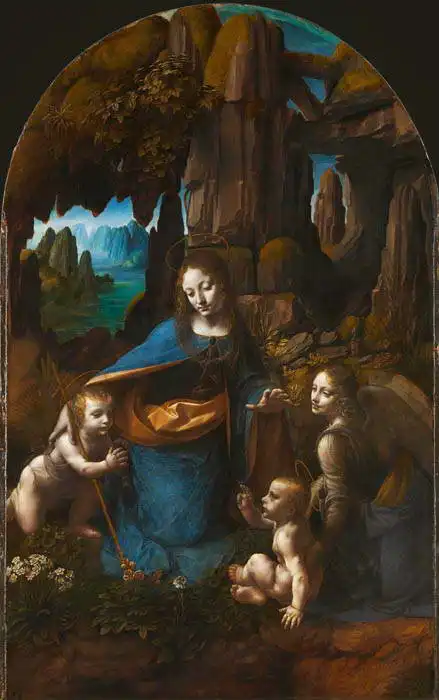About this finishing
Print. The image is printed on the top quality 10-ink HP Z9PS printer on HP matte 270 g / m2 paper. You can choose any size to an accuracy of 1 cm. A margin of 5 cm around the image is added to the size of the motif.


You can find a detailed description about our finishings
here.
Virgin of the Rocks
Date:
1508Medium:
oil on boardLocation:
LondonThe Madonna is depicted in a fictional rocky landscape, which in the background opens up to two distant vistas. Mary embraces John the Baptist with her right hand, blesses Jesus with her left (John kneels before Jesus, who blesses him with two fingers). The iconography is traditional, Catholic and emphasizes the relationships in the Gospel (Mary as the mother of Jesus and relative and protector of John the Baptist). The angel only complements the composition and enriches the whole composition. What is unusual is that the characters are of a child's age but act like adults. The landscape in the background is barren and unfriendly, referring to the influence of sin in the world. This painting is a second version of the original painting, which is fully attributed to Leonardo da Vinci. They differ in color, a greater proportion of blue and some details of the figures (the angel looks more to the side, John the Baptist has a traditional staff with the sign of the cross, etc.). The painting was most likely painted by Vinci only in part, the rest was created in his workshop (under his guidance, the painting was completed by Vinci's student Ambrogio de Predis.
Vinci painted picture Virgin of the Rocks in 1508. Prevailing color of this fine art print is brown and its shape is portrait. This art piece is located in London. This image is printed on demand - you can choose material, size and finishing.
Leonardo da Vinci (1452-1519). He was an important Italian
Renaissance painter, sculptor, architect, musician, mathematician and inventor. He is even considered the greatest humanist of all time. His works are special and innovative thanks to the search of compositional balance, the movement of characters and perspectives achieved by the play of light and colour. He used a distinctive colour blending technique known as sfumato. His attempt to capture the character, mood and expression of people was also significant. Among his most famous works are
The Last Supper, Lady with an Ermine, Self Portrait and of course
Mona Lisa, which is one of the most famous works of art in the history of painting.


